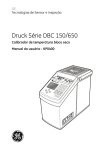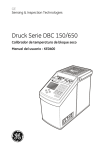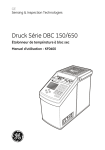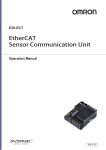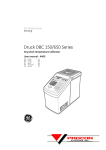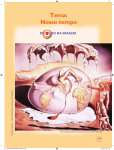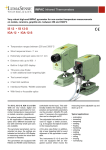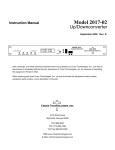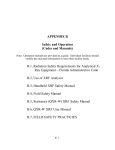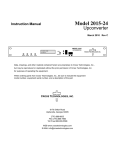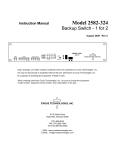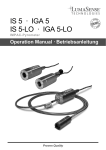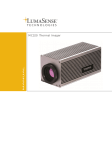Download Series IN 500 Operating Manual
Transcript
OPERATION MANUAL Series IN 500 IMPAC Pyrometers IN 510-N • IN 510 • IN 520-N • IN 520 • IN 530-N • IN 530 Confidential Information The material contained herein consists of information that is the property of LumaSense Technologies and intended solely for use by the purchaser of the equipment described in this manual. All specifications are subject to change without notice. Changes are made periodically to the information in this publication, and these changes will be incorporated in new editions. LumaSense Technologies prohibits the duplication of any portion of this manual or the use thereof for any purpose other than the operation or maintenance of the equipment described in this manual, without the express written permission of LumaSense Technologies. Copyright © LumaSense Technologies 2011. All rights reserved. Trademarks IMPAC is a trademark of LumaSense Technologies. All other trademarks are trademarks, registered trademarks, and/or service marks of their respective holders. LumaSense Technologies, Inc. 3301 Leonard Court Santa Clara, CA 95054 USA Telephone +1 (408) 727-1600 FAX +1 (408) 727-1677 E-mail [email protected] [email protected] Website http://www.lumasenseinc.com Americas and Australia Sales & Service Santa Clara, CA Ph: +1 800 631 0176 Fax: +1 408 727 1677 Europe, Middle East, Africa Sales & Service Frankfurt, Germany Ph: +49 69 97373 0 Fax: +49 69 97373 167 India Sales & Support Center Mumbai, India Ph: +91 22 67419203 Fax: +91 22 67419201 China Sales & Support Center Shanghai, China Tel: +86 133 1182 7766 Fax: +86 21 5039 8096 Part No 550-0000-01 Revision A October 2011 Contents 1 General ........................................................................................................................... 5 1.1 1.2 1.3 1.4 2 Introduction .................................................................................................................... 7 2.1 2.2 2.3 2.4 2.5 2.6 2.7 3 The connection cable ............................................................................................ 12 The connection ..................................................................................................... 12 Connecting to serial interface ............................................................................... 13 Optics ............................................................................................................................ 15 4.1 4.2 4.3 5 Appropriate use ...................................................................................................... 7 Components ............................................................................................................ 7 Accessories .............................................................................................................. 8 Unpacking the Instrument ...................................................................................... 8 Transport, packaging, storage ................................................................................ 8 Malfunction or Service Request............................................................................... 9 Shipments to LumaSense for Repair ........................................................................ 9 Installation .................................................................................................................... 11 3.1 3.2 3.3 4 Information about the user manual ........................................................................ 5 1.1.1 Legend ................................................................................................................. 5 1.1.2 Terminology ........................................................................................................ 5 Safety ...................................................................................................................... 5 1.2.1 General ................................................................................................................ 5 1.2.2 Electrical connection ........................................................................................... 5 Disposal / decommissioning ..................................................................................... 6 Limit of liability and warranty ................................................................................ 6 Sensor head........................................................................................................... 15 4.1.1 Exchangeability of Sensor heads ....................................................................... 15 Exchange of sensor head ....................................................................................... 16 Error messages at non-specified sensor temperatures ........................................... 17 Device Settings .............................................................................................................. 19 5.1 Parameters ............................................................................................................ 19 5.1.1 Emissivity (EMI) .................................................................................................. 19 5.1.2 Response time (T90) .......................................................................................... 20 5.1.3 Clear time (TCL) ................................................................................................. 20 5.1.4 Selection of the maximum or minimum value storage (MAX or MIN) ............. 20 5.1.5 Subrange (LO / HI) ............................................................................................. 20 5.1.6 Analog output (OUT) ........................................................................................ 21 5.1.7 Temperature display (°C / °F) ............................................................................. 21 5.1.8 Compensation of ambient temperature (CMP)................................................. 21 5.1.9 Sensor head temperature (AMB)....................................................................... 21 5.1.10 Baud rate (BD) ................................................................................................... 21 5.1.11 Address (AD) ...................................................................................................... 21 5.1.12 Limit switch (LIM) .............................................................................................. 21 5.1.13 Hysteresis (HYS) ................................................................................................. 22 Series IN 500 Operating Manual Contents iii 5.2 5.3 5.1.14 Wait time (only available via interface commands, see section 8.1, Data format UPP®) ............................................................................................. 22 Settings at the instrument (only IN 510, IN 520, and IN 530) ................................ 22 Settings with HT 6000 (accessory) ......................................................................... 23 6 Settings via interface and software ............................................................................... 25 7 Maintenance ................................................................................................................. 27 7.1 7.2 8 Appendix....................................................................................................................... 29 8.1 8.2 8.3 9 Safety .................................................................................................................... 27 Service ................................................................................................................... 27 Data format UPP (Universal Pyrometer Protocol) ................................................ 29 Technical Data....................................................................................................... 32 8.2.1 Dimensions ........................................................................................................ 34 8.2.2 Scope of delivery ............................................................................................... 34 Reference numbers ............................................................................................... 35 8.3.1 Reference numbers instruments ....................................................................... 35 8.3.2 Reference numbers accessories ......................................................................... 36 Index ............................................................................................................................. 37 Series IN 500 Operating Manual Contents iv 1 General 1.1 Information about the user manual Congratulations on choosing this high quality and highly efficient IMPAC pyrometer. This manual provides important information about the instrument and can be used as a work of reference for installing, operating, and maintaining your pyrometer. It is important that you carefully read the information contained in this manual and follow all safety procedures before you install or operate the instrument. To avoid handling errors, keep this manual in a location where it will be readily accessible. 1.1.1 Legend Note: The note symbol indicates tips and useful information in this manual. All notes should be read to effectively operate the instrument. Attention: This sign indicates special information which is necessary for a correct temperature measurement 1.1.2 Terminology The used terminology corresponds to the VDI- / VDE-directives 3511, part 4. 1.2 Safety This section offers an overview about important safety aspects. 1.2.1 General Each person working with the pyrometer must have read and understood the user manual before operation. This also has to be done if the person has already used similar instruments or was already trained by the manufacturer. The pyrometer is only to be used for the purpose described in the manual. It is recommended to use only accessories offered by the manufacturer. 1.2.2 Electrical connection Follow common safety regulations for mains voltage (230 or 115 V AC) connecting additional devices operating with this mains voltage (e.g. transformers). Touching mains voltage can be fatal. An incorrect connection and mounting can cause serious health or material damages. Only qualified specialists are allowed to connect such devices to the mains voltage. Series IN 500 Operating Manual General 5 1.3 Disposal / decommissioning Inoperable IMPAC pyrometers must be disposed of in compliance with local regulations for electro or electronic material. 1.4 Limit of liability and warranty All general information and notes for handling, maintenance and cleaning of this instrument are offered according to the best of our knowledge and experience. LumaSense Technologies is not liable for any damages that arise from the use of any examples or processes mentioned in this manual or in case the content of this document should be incomplete or incorrect. LumaSense Technologies reserves the right to revise this document and to make changes from time to time in the content hereof without obligation to notify any person or persons of such revisions or changes. All IMPAC Series 510, 520, and 530 instruments from LumaSense Technologies have a regionally effective warranty period. This warranty covers manufacturing defects and faults which arise during operation, only if they are the result of defects caused by LumaSense Technologies. Disassembly of the instrument is not allowed. The warranty is VOID if the instrument is disassembled, tampered with, altered, or otherwise damaged without prior written consent from LumaSense Technologies; or if considered by LumaSense Technologies to be abused or used in abnormal conditions. Series IN 500 Operating Manual General 6 2 Introduction 2.1 Appropriate use The IN 510-N, IN 510, IN 520-N, IN 520, IN 530-N and IN 530 are stationary pyrometers for non-contact temperature measurement of non-metallic surfaces or painted, coated or anodized metals. The versions IN 510, IN 520, and IN 530 are equipped with an illuminated LC display which shows the actual temperature reading. All available parameters can be set via the integrated keyboard. The types IN 510-N, IN 520-N, and IN 530-N do not have display and keyboard, they will be parametrized via interface. The types 510 are equipped with sensor head and sensor cable for an ambient temperature of max. 85°C without cooling, types 520 and 530 are equipped with sensor head and sensor cable up to 180°C without cooling. 2.2 Components Converter Series IN 500 Operating Manual Sensor Head Introduction 7 2.3 Accessories Numerous accessories guarantee easy installation of the pyrometers. The following overview shows a selection of suitable accessories. You can find the entire accessory program with all reference numbers on section 8.3.2 Reference numbers accessories. Mounting angle for sensor head HT 6000: Portable battery driven instrument for setting of pyrometer parameters 2.4 DA 6000: Led digital display with possibility for setting of pyrometer parameters Air purge for sensor head 10:1 and 2:1 Power supply NG DC 100…240 V AC 24 V DC Connecting cable with additional interface cable/plug Unpacking the Instrument Thoroughly inspect the instrument upon delivery to the purchaser. Check all materials in the container against the enclosed packing list. LumaSense Technologies cannot be responsible for shortages against the packing list unless a claim is immediately filed with the carrier. Final claim and negotiations with the carrier must be completed by the customer. Save all packing materials, including the carrier’s identification codes, until you have inspected the pyrometer and find that there is no obvious or hidden damage. Before shipment, the pyrometer was examined and has been tested. If you note any damage or suspect damage, immediately contact the carrier and LumaSense Technologies, Inc. 2.5 Transport, packaging, storage In case the pyrometer is not put into service immediately, it should be tested in the application or simulated application as promptly as practical to reveal any hidden damage. Unpleasant surprises can be avoided by briefly trying any spare pyrometer before putting it in storage. The instrument can be damaged or destroyed if shipped incorrectly. To transport or store the instrument, please use the original box or a box padded with sufficient shock-absorbing material. For storage in humid areas or shipment overseas, the device should be placed in welded foil (ideally along with silica gel) to protect it from humidity. The pyrometer is designed for a storage temperature of -20 … 70°C with non-condensing conditions. Other kind of storage can damage or malfunction the pyrometer. Series IN 500 Operating Manual Introduction 8 2.6 Malfunction or Service Request Contact LumaSense Technologies Technical Support in case of a malfunction or service request. Provide clearly stated details of the problem as well as the instrument model number and serial number. Upon receipt of this information, Technical Support will attempt to locate the fault and, if possible, solve the problem over the telephone. If Technical Support concludes that the instrument must be returned to LumaSense Technologies for repair, they will issue a Return Material Authorization (RMA) number. Return the instrument upon receipt of the RMA number, transportation prepaid. Clearly indicate the assigned RMA number on the shipping package exterior. Refer to Section 2.7, Shipments to LumaSense for Repair, for shipping instructions. Technical Support can be contacted by telephone or email: Santa Clara, California Telephone: (408) 727-1600 or 1-800-631-0176 Email: [email protected] Frankfurt, Germany Telephone: +49 69 97373 0 Email: [email protected] 2.7 Shipments to LumaSense for Repair All RMA shipments of LumaSense Technologies instruments are to be prepaid and insured by way of United Parcel Service (UPS) or preferred choice. For overseas customers, ship units airfreight, priority one. The instrument must be shipped in the original packing container or its equivalent. LumaSense Technologies is not responsible for freight damage to instruments that are improperly packed. Contact us to obtain an RMA number (if one has not already been assigned by Technical Support). Clearly indicate the assigned RMA number on the shipping package exterior. Send RMA Shipments to your nearest technical service center: Santa Clara, California Frankfurt, Germany LumaSense Technologies, Inc. 3301 Leonard Court Santa Clara, CA 95054 USA Telephone: (408) 727-1600 1-800-631-0176 LumaSense Technologies GmbH Kleyerstr. 90 60326 Frankfurt Germany Telephone: +49 69-97373 0 Email: [email protected] Email: [email protected] Series IN 500 Operating Manual Introduction 9 To ensure consistent document formatting, this page was intentionally left blank. Series IN 500 Operating Manual Introduction 10 3 Installation The pyrometers are powered by 24 V DC (possible range: 10 ... 30 V DC). When connecting the instrument to the power supply ensure correct polarity. To switch off the instrument the power supply has to be interrupted. To meet the electromagnetic requirements (EMV), a shielded connecting cable must be used. The shield of the connecting cable (diameter: 3 - 6.5 mm, max. 12 wires) has to be connected only on the pyrometer’s side. If the connecting cable is extended, the shield of the extension also needs to be extended. On side of the power supply (switch board) the shield must be open to avoid ground loops. 1 2 3 4 5 6 7 8 Connection signal output and power supply RS485 „A2“ RS485 „B2“ Relay contact (isolated) (pink) Relay contact (isolated) (grey) RS232 interface TxD (RS485 „A1“) (violet) RS232 interface DGND RS232 interface RxD (RS485 „B1“) Sensor head temp. (connection to GND) Analog output mA or V or type K or type J (connection to GND) 10 GND (- OUT) 11 0 V 12 +10 ... +30 V DC 9 Series IN 500 Operating Manual (red) (black) (blue) (green) (yellow) (brown) (white) 4 3 2 1 Connection sensor head NTC resistor (yellow) NTC resistor (green) Thermopile (+) (white) Thermopile (-) (brown) Notes: The sensor head is already connected to the converter (state of delivery). For differentiation between sensor heads of series 530 and series 520: 530: resistor betw. 1 and 2: 80 k 520: resistor betw. 1 and 2: 20 k Installation 11 3.1 The connection cable The connecting cable has to be selected according to the following criteria: Shielded Diameter 3 - 6.5 mm Quantity of wires: if necessary 2 to 12: - 2 for power supply. additionally, if required: - 1 for analog output - 1 for sensor head temperature - 1 GND for analogue output and / or sensor head temperature - 3 or 4 for digital interface - 2 for relay contact 3.2 The connection Grounding Wire Bridge Fig. 2 1. Prepare the cable as shown in Fig. 1 . 2. The shielding of the connecting cable has to be pushed over the plastic sleeve 2 mm further than the O-ring. 3. Fix the cable with the clamp screw. 4. At state of delivery an internal connection between contact 11 and the housing exists. Should the housing have its own earth potential caused by an electric connection to an object, the internal connection has to be removed. Fig. 2 . The screw bars inside the converter can be lifted up for easy installation of the wires (input/output cables and sensor head) Fig. 3 . Fig. 3 _________________________________________________ Caution: Before connecting the pyrometer to other instruments (e.g. controller, PLC, etc.) the correct analog output (current, voltage or thermocouple), corresponding to the input of the instrument, has to be adjusted at the converter. A wrong output might damage the connected instrument. Series IN 500 Operating Manual Installation 12 Fig. 4 : For mounting of the converter housing, there are two holes with 4 mm screws. Fig. 4 After mounting, connecting cables and parametrizing (if necessary), close the cover of the converter and tighten the 4 screws. mounting of converter Note: If using the pyrometer with measuring output thermocouple type K or J, this output has to be connected with the correct compensating cable. Connecting to serial interface The pyrometers are equipped with a serial interface RS232 or RS485 (switchable at the pyrometer). Only short distances can be transmitted with RS232 and electromagnetic interferences can affect the transmission. With RS485 the transmission is to a large extent free of problems. Long transmission distances can be realized and several pyrometers can be connected in a bus system. The transmission rate (in baud) of the serial interface is dependent on the length of the cable. Values between 1200 and 19200 Bd may be set. Typical cable length for RS232 at 19200 Bd is 7 m. Typical cable length for RS485 at 19200 Bd is 2 km. Connection example of 2 instruments with RS485: 120 A2 B2 RS232 RS485 TxD/A1 GND RxD/B1 24 V DC 0V +24 V Pyrometer 1, e.g. address 00 A2 B2 Master 3.3 A B 24 V DC RS232 RS485 TxD/A1 GND RxD/B1 0V +24 V Pyrometer 2, e.g. address 01 Series IN 500 Operating Manual Installation 13 To ensure consistent document formatting, this page was intentionally left blank. Series IN 500 Operating Manual Installation 14 4 Optics 4.1 Sensor head Two different optical head types with a field of view 10:1 or 2:1 are available. The spot sizes at different measuring distances are shown in the drawings below; intermediate values have to be interpolated. An additional close focus lens is available for the 10:1 head of series 510 instruments (temperature resistant up to 85°C) that can be used to generate a small spot size in a short distance. 4.1.1 Exchangeability of Sensor heads Whether a sensor head can be used with a different electronic box is indicated by the identifier "S1" on the sensor cable: IN 500: optical heads 2:1 (S1 0xxx) and 10:1 (S1 1xxx) can be used with any electronic box. IN 510: optical heads 2:1 and 10:1 (both S1 0xxx) can be used with any electronic box. IN 520: optical heads 2:1 and 10:1 (both S1 2xxx) can only be used with IN 520 electronic boxes IN 530: optical heads 2:1 and 10:1 (both S1 4xxx) can only be used with IN 530 electronic boxes When connecting a new sensor head to the electronic box, the respective 8-digit pin-code has to be set (see section 4.2 Exchange of sensor head). Note: The pyrometer can measure objects at any distance but the farther the distance, the larger is the measuring area (spot size). The object has to be bigger or at least as big as the spot size of the pyrometer in the measuring distance. Series IN 500 Operating Manual Optics 15 4.2 Exchange of sensor head Note: Whether a sensor head can be used with a different electronic box is indicated by the identifier "S1" on the sensor cable. See section 4.1.1 for more information. The sensor head is exchangeable if a sensor head with other optical data or a longer cable is required. Each sensor head cable is marked with a label containing a sensor code which has to be set in the pyrometer. The sensor head cable is available in lengths of 3 or 15 m which can be cut to any required length. The sensor code label should be affixed to the remaining part of the cable. The cable has to be prepared in accordance with the illustration. The shield must be pushed above the washer and O-rings, then the cable can be pushed into the converter and fixed with the clamp screw (series 510) or soldered to the pins (series 520 and series 530). (For cable connection see schematic in section 3, Installation). The sensor code at the cable has to be set in the pyrometer as follows: Setting via software: Set these codes S1 and S2 in “Pyrometer parameters“ under the button and confirm them with “OK”. Now the new sensor head is matching to the converter and the pyrometer is ready for measuring. Additionally in the IN 510, IN 520, or IN 530 the setting of the sensor head codes can be done via internal push buttons: Remove the cover of the converter and press the buttons and simultaneously. While pressing these two buttons push the “PAR” button too. The display shows code S1. With the arrow buttons and the new code S1 has to be set and confirmed with the “PAR” button. Now code S2 appears on the display and has to be set and confirmed in the same way. A setting of these codes with the HT 6000 or digital display DA 6000 is not possible. Series IN 500 Operating Manual Optics 16 4.3 Error messages at non-specified sensor temperatures The pyrometer gives the following error messages for the protection of the electronics and the machines if the temperature of the sensor head is out of specified values: Excess of specified sensor head temperature (corresponding to the model: 85°C or 180°C): - Output of the serial interface code 75550 - Output of the analog output: 22 mA at 0/4 ... 20 mA, 5 V at 0 ... 5 V, excess of end of measuring range at thermocouple output - The relay is de-energized (contact open) - Display of IN 510, IN 520, or IN 530: ERR 1 instead of the temperature reading Sensor head temperature falls below specified value (0°C): - Output of the serial interface code 74440 - Output of the analog output: 22 mA at 0/4 ... 20 mA, 5 V at 0 ... 5 V, excess of end of measuring range at thermocouple output - The relay is de-energized (contact open) - Display of IN 510, IN 520 or IN 530: ERR 2 instead of the temperature reading There is no error message if the converter temperature runs out of its specified operating temperature. Series IN 500 Operating Manual Optics 17 To ensure consistent document formatting, this page was intentionally left blank. Series IN 500 Operating Manual Optics 18 5 Device Settings 5.1 Parameters The setting of the parameters of the IN 510-N, IN 520-N, or IN 530-N can only be done via serial interface (see also section 6, Settings via interface and software and section 5.3 Settings with HT 6000 (accessory)), the parameters of the IN 510, IN 520, and IN 530 additionally can be done by integrated push buttons inside the converter (see section 5.2 Settings at the instrument). 5.1.1 Emissivity (EMI) For a correct measurement, it is necessary to adjust the emissivity. This emissivity is the relationship between the emission of a real object and the emission of a black body radiation source (this is an object which absorbs all incoming rays and has an emissivity of 100%) at the same temperature. Different materials have different emissivities ranging between 0% and 100% (settings at the pyrometer between 10 and 100%, an additional attenuation, setting from 100 to 120% can be used for example to correct the measurement of objects behind gases with hot soot). Additionally the emissivity is dependent upon the surface condition of the material, the spectral range of the pyrometer and the measuring temperature. The emissivity setting of the pyrometer has to be adjusted accordingly. Typical emissivity values of various common materials for the two spectral ranges of the instruments are listed below. The tolerance of the emissivity values for each material is mainly dependent on the surface conditions. Rough surfaces have higher emissivities. Object " Black body furnace " Human skin Black dull varnish Carbon soot Wood Paper Asphalt Glass / Quartz glass Textile Graphite Cement Water Emissivity (%) 100 98 95 95 80 ... 92 92 ... 95 85 72 ... 87 75 ... 95 75 ... 92 90 95 Series IN 500 Operating Manual Object Brickwork Fire clay Rubber Porcelain Ceramics Varnish Plaster Oil paint Steel (oxidized) Steel (smooth) Aluminum (smooth) Aluminum (anodized) Emissivity (%) 85 ... 95 60 ... 80 10 ... 30 2 ... 15 96 Device Settings 19 5.1.2 Response time (T90) Settings: The response time is the time interval between the instant of an abrupt change in OFF the value of the measuring temperature and the instant from which the measured 0.5 .. s value of the pyrometer remains within specified limits. The time is taken to reach . 90% of the recorded temperature difference. In the OFF position, the device 30 s operates using his time constant (shortest response time). Longer response times can be used for the measurement of objects which have rapidly fluctuating temperatures to achieve constant temperature reading. 5.1.3 Clear time (TCL) The maximum value storage (or minimum value storage) stores the highest (or lowest) measurement value. The clear time defines the time period until the stored value is deleted and replaced by a new one. The following settings are possible: Clear time “OFF“: The storage is switched off and only momentary values are measured. Settings: OFF 0.1 .. s . 25 s extern auto If any clear time TCL is set either the maximum value or minimum value storage will be cleared. The “auto” mode is used for discontinuous measuring tasks. For example objects are transported on a conveyer belt and pass the measuring beam of the pyrometer only for a few seconds. Here the maximum (minimum) value for each object has to be indicated. In this mode, the maximum (minimum) value is stored until a new hot (or cold) object appears in the measuring beam. The temperature which has to be recognized as “hot“ (or “cold“) is defined by the low (high) limit of the adjusted sub range. The stored maximum value will be deleted when the temperature of the new hot object exceeds the low limit LO of the sub range by 1% or at least 2°C. The stored minimum value will be deleted when the object temperature falls below the high limit HI of the sub range by 1% or at least 2°C. The external clearing (“extern”) of the storage can only be activated and used with an own software (see data format UPP , section 8.1). 5.1.4 Selection of the maximum or minimum value storage (MAX or MIN) With this setting you choose between maximum or minimum value storage if the storage function is activated by setting TCL. If TCL is switched “OFF”, the storage function is not activated, the indication of “MAX“ or “MIN“ only shows the preselection. 5.1.5 Settings: MAX MIN Subrange (LO / HI) Settings: You have the opportunity to choose a subrange (minimum 51°C) within the basic 700°C .. measuring range of the pyrometer. This subrange corresponds to the analog . output. LO describes the beginning of this measuring range, HI the end of the -40°C range. If the thermocouple output is used, the analog output does not change. In addition, with the setting of a subrange it is possible to fulfill the requirements of the “auto” clear mode of the maximum or minimum value storage (see above). Series IN 500 Operating Manual Device Settings 20 5.1.6 Analog output (OUT) The analog output has to be selected according to the signal input of the connected instrument (controller, PLC, etc.). You can choose between current output (0 or 4 to 20 mA), voltage output (0 to 5 V) or thermocouple output type J or K. Settings: 0-20 mA 4-20 mA 0-5 V type J type K Caution: Before connecting the pyrometer to other instruments (e.g. controller, PLC, etc.) the correct analog output (current, voltage or thermocouple), corresponding to the input of the instrument, has to be adjusted in the converter. A wrong output might damage the connected instrument. 5.1.7 Settings: °C °F Temperature display (°C / °F) The temperature can be displayed in °C or °F. 5.1.8 Compensation of ambient temperature (CMP) Settings: This compensation is used for a very few special applications only. The standard 700°C .. setting of this parameter is “auto”, because the temperature of the sensor head is . normally the ambient temperature of the measured object. Should the measured -40°C object be placed in an area with a higher ambient temperature (e.g. inside a auto furnace), the measurement might be falsified (probably too high temperature indication). This influence can be compensated by presetting of the ambient temperature of the object with help of the CMP-function (presetting within the measuring range of the instrument). It has to be considered, that this method only improves the results if the ambient temperature at the place of the measured object is always constant. 5.1.9 Sensor head temperature (AMB) The temperature of the sensor head can be displayed. 5.1.10 Baud rate (BD) The transmission rate of the serial interface in Baud (Bd) is dependent on the length of the cable. The standard cable length with RS232 for 19200 Bd is 7 m, with RS485 2 km. The baud rate is reduced by 50% if the transmission distance is doubled. Settings: 19200 .. Bd . 1200 Bd 5.1.11 Address (AD) Settings: For connecting several pyrometers with RS485 (up to 32) with one serial interface, 31 .. it is necessary to give each instrument an individual address for communication. . First it is necessary to connect each single instrument to give it an address. After 00 that, all instruments can be connected and addressed individually. If parameters may be changed simultaneously on all pyrometers, the global address 98 can be used. This allows you to program all pyrometers at the same time, regardless of the addresses that have already been assigned. If the address of a pyrometer is unknown, it is possible to communicate with it using the global address 99 (connect only one pyrometer). 5.1.12 Limit switch (LIM) The instruments are equipped with a relay contact, controlled by the measuring signal. The switch point of this relay is adjustable with the function ”LIM” within the measuring range. The relay contact is closed below the adjusted value, it is open above it. Series IN 500 Operating Manual Settings: 700°C .. . -40°C Device Settings 21 5.1.13 Hysteresis (HYS) The relay contact opens immediately when the temperature exceeds the adjusted “LIM“ value, it closes only if the temperature falls below a value which consists of “LIM“ and the adjusted hysteresis. Settings: 20°C .. . 2°C 5.1.14 Wait time (only available via interface commands, see section 8.1, Data format UPP®) When using a pyrometer with RS485, it is possible that the connection is not fast enough to receive the pyrometer’s answer to an instruction of the master. In this case, a wait time can be set to slow down the data transfer (e.g.: tw = 02 at a baud rate 9600 means a wait time of 2/9600 sec). Standard settings at delivery: EMI=100; T90=OFF; TCL=OFF; MAX/MIN=MAX; OUT=0...20 mA; LO=0°C; HI=500°C; °C/°F=°C; CMP=auto; BD=19200; AD=00; LIM=0°C; HYS=2°C 5.2 Settings at the instrument (only IN 510, IN 520, and IN 530) The buttons for parametrizing the IN 510, IN 520 or IN 530 are inside the converter and are accessible after removing the cover (4 screws). Interface switch: RS232 RS485 Selection of parameters: the parameters are called with the button PAR (the sequence is described on section 5). If no button is pushed for approx. 15 s, the instrument switches back to measuring mode with the latest parameter settings. A changed value of a parameter is automatically stored after changing to another parameter. Up / down buttons ( ): After selection of one parameter with the PAR button the up / down buttons are used to set the available values. Note: Do not operate the converter permanently with open cover. Series IN 500 Operating Manual Device Settings 22 5.3 Settings with HT 6000 (accessory) The HT 6000 is a portable battery driven instrument for the parameter setting of digital pyrometers and for indication of temperature. The pyrometer has to be connected to the HT 6000 via its interface cable (RS232 or RS485) with the female SUB-D connector. When the HT 6000 is switched on it recognizes the pyrometer automatically and the preset parameters can be displayed. With the “PAR” button the different parameters can be called in the sequence described on section 5.1 Parameters. With the arrow buttons and the values of the parameters can be selected and confirmed with the “ENTER” button. If no button is pressed for 30 s the HT 6000 changes to the temperature indication without accepting the changed value. Series IN 500 Operating Manual Device Settings 23 To ensure consistent document formatting, this page was intentionally left blank. Series IN 500 Operating Manual Device Settings 24 6 Settings via interface and software The entire parameters are adjustable via serial interface and PC software InfraWin (latest version is available as download from the homepage www.lumasenseinc.com; min. system requirements Windows 98 SE) or via self created user communication software (see UPP® table, section 8.1). After installation of the software (select the setup program and follow the installation instructions) and start of InfraWin, the start menu allows access to the several program function: Opens a saved file Storage of measured values for further processing Online measurement with color bar display Online measurement with graphic display Setting of the parameters of the instrument Setting of interface, baud rate and pyrometer addresses (RS485) Time interval between two measurements Number of connected instruments (max. 2) Listing of measured or stored values in tabular form Processing of measured (stored) readings in graph form Processing of measured (stored) readings in a text file Calculation of spot sizes in various measuring distances Only if available: controls the programmable controller PI 6000 Before using the software, the serial interface(s) connected to the pyrometer(s) has (have) to be selected under the Computer icon. Afterwards all preset pyrometer parameters can be displayed and modified. The window pyrometer parameter contains all parameter settings described in section 5.1. Choose the correct setting for your application, the actual setting is displayed. Notes: “Basic range” displays the total range of the pyrometer automatically and cannot be changed. If you select a clear time longer than 0 s (OFF) you have to choose “max“ or “min“ in the next line to define either maximum value storage or minimum value storage. If it is necessary to activate the ambient temperature compensation, you have to switch to “man”. Then the Series IN 500 Operating Manual Settings via interface and software 25 small window T(Amb) appears and the temperature correction can be done. In position “auto” it is assumed that the ambient temperature of object and sensor head is the same (standard setting). Under “Material“ you have the possibility to store the names of different measuring objects with their emissivity values and to recall them from the list. “1 meas.” shows the current measuring temperature in the pyrometer parameters window for approx. 1 second. “Test” opens a window that allows the direct communication with the pyrometer via the interface commands (see section 8.1 Data format UPP®). Additionally a connection test with the preset baud rate can be done. Via the “open/save” symbols all settings can be stored and restored. Further program functions are described in the online help of the software. Series IN 500 Operating Manual Settings via interface and software 26 7 Maintenance 7.1 Safety Attention during pyrometer services: Should the pyrometer be integrated in a running machine process, the machine has to be switched off and secured against restart before servicing the pyrometer. 7.2 Service The pyrometer does not have any parts which require regular service, only the lens has to be kept clean. The lens can be cleaned with a soft cloth in combination with alcohol (do not use acid solutions or dilution). Also standard cloths for cleaning glasses or photo objectives can be used. The lens of the 10 : 1 sensor head has an anti-reflective coating which appears slightly colored. Be extremely careful - this layer can easily be rubbed off - this will greatly affect the measuring results! Series IN 500 Operating Manual Maintenance 27 To ensure consistent document formatting, this page was intentionally left blank. Series IN 500 Operating Manual Maintenance 28 8 Appendix 8.1 Data format UPP (Universal Pyrometer Protocol) Via interface and suitable communication software or via “Test” function of the InfraWin software (section “pyrometer parameters”) commands can be exchanged directly with the pyrometer. The data exchange occurs in ASCII format with the following transmission parameters: The data format is: 8 data bits, 1 stop bit, even parity (8,1,e) The device responds with the entry of a command with: output (e.g. the measuring value) + CR (Carriage Return, ASCII 13), with pure entry commands with "ok" + CR. With invalid commands the instruments answers with „no“ + CR. Every command starts with the 2-digit device address AA (e.g. "00"). This is followed by 2 small command letters (e.g. "em" for level of emissivity ), finished with CR This is followed, if necessary for that command, by the ASCII parameter "X". If this parameter "X" is omitted, then the device resets with the current parameter. Example: Entry: “00em“ + CR The emissivity setting of the device with the address 00 is returned Answer: “0970“ + CR means emissivity = 0.970 or 97.0% Series IN 500 Operating Manual Appendix 29 Description Reading measuring value: Command AAms repeatedly reading measuring values: Emissivity: Response time t90: AAmsXXX Setting clear time tCL: AAlzX External clearing: Setting maximum / minimum value: Read. max/min value: Reading basic measuring range: AAlx AAmiX Reading sub range: Setting sub range: AAme AAm1YYYYZZZZ Analog output 1): AAasX AAemXXXX AAezX AAmi AAmb Temperature display 1): AAfhX Reading ambient temperature: Entering ambient temperature: AAut Sensor head temp.: Max. sensor head temp.: Baud rate: AAgt AAtm Instrument address 1): AAgaXX Reading switch point: Setting switch point: AAsl AAslXXXX AAutXXXX AAbrX Series IN 500 Operating Manual Parameters Output: YYYYY; 5-digit decimal, in 1/10 °C or °F 88880 = temperature-overflow 75550 = exceed max. sensor head temp. 74440 = fall below min. sensor head temp. 02563 = 256.3 °C or °F; -0170 = -17.0 °C or °F XXX = 000 ... 999 XXX = Number of measuring values XXXX = 0100 ... 1200 in ‰ X = 0 ... 6 (decimal) 0 = intrinsic time constant of the device 1 = 0.5 s 2=1s 3=2s 4=5s 5 = 10 s 6 = 30 s X = 0 ... 8 (decimal) 0 = Max. value- / min. value storage off 1 = 0.10 s 5 = 5.00 s 2 = 0.25 s 6 = 25.00 s 3 = 0.50 s 7 = external clearing 4 = 1.00 s 8 = automatic clearing Simulation of an external reset contact X = desired setting 0 = maximum value, 1 = minimum value Output: 0 or 1; 0 = max value, 1 = min value Output: YYYYZZZZ (8-digit hex) 2) YYYY = beginning of measuring range ZZZZ = end of measuring range as with mb YYYY = beginning of measuring range ZZZZ = end of measuring range X = 0 ... 4 2 = 0 ... 5 V 0 = 0 ... 20 mA 3 = thermocouple type K 1 = 4 ... 20 mA 4 = thermocouple type J X = 0;1 0 = Output Celsius 1 = Output Fahrenheit Output: stored value, 4-digit hex 2) e.g. 0258 corresponds to 600 degrees XXXX = Value of ambient temp., 4-digit hex 2) XXXX z.B. FFEC corresponds to -20 degrees -99dez = FF9Dhex means: automatic, no manual compensation Output: XXX (dec. 000...180°C or 032...356°F) Output: XXX (dec. 000...180°C or 032...356°F) X = 0 ... 4 0: 1200 bd 1: 2400 bd 2: 4800 bd 3: 9600 bd 4: 19200 bd XX: device address decimal; 00 ... 31 variable device addresses; global: 98, 99 Output: XXXX (4-digit hex) 2) XXXX (4-digit hex) 2); adjustable within sub range Appendix 30 Reading hysteresis: AAhlXX Setting hysteresis: Wait time: Reading sensor data: AAhl AAtwXX AAse Setting sensor data: Reset 1): Reading parameters: AAseXXXXYYYY AAre AApa Error status: AAfs Serial number: Type / software version: AASsn AAve XX (2-digit hex) 2); XX setting 2 ... 20°C (4 ... 36°F) Output: XX (2-digit hex) 2) XX = 00 ... 99 relative delay value Output: XXXXYYYY (8-digit decimal); Reading of adjusted sensor data: XXXX: S1; YYYY: S2 XXXXYYYY (8- digit dec.); entering sensor data Reset device Output 11-digit decimal: Digit 1 and 2 (10...99 or 00): EMI up to 100 Digit 3 (0 ... 6): t90 (response time) Digit 4 (0 ... 8): tCL (storage clear mode) Digit 5 (0 / 4): analog output Digit 6 and 7 (00 ... 99): sensor head temp. Digit 8 and 9 (00 ... 31): device address Digit 10 (0 ... 4): device baud rate Digit 11 (always 0) Output: XX; XX=00…FF (00 = no error) (01…FF: error code for LumaSense service) Output: XXXXX (5-digit decimal) Output: XXYYZZ (6-digit decimal) XX = 76 (IN 510, IN 520, IN 530); YY = Month of software version ZZ = Year of software version Notes: - the letter “l” means the lower case letter of “L” - bold values = default settings After entering these commands the device carries out an automatic reset. The device needs approx. 150 ms before it is ready to use and work with the changed settings. The input and output corresponds to the preset degree C or degree F. Additional instruction for the RS485 interface Requirements to the master system during half-duplex operation: 1. After an inquiry, the bus should be switched into a transmission time of 3 bits (some older interfaces are not fast enough for this). 2. The pyrometer's response will follow after 5 ms at the latest. 3. If there is no response, there is a parity or syntax error and the inquiry has to be repeated. After receiving the response, the master has to wait at least 1.5 ms before a new command can be entered. Series IN 500 Operating Manual Appendix 31 8.2 Technical Data Temperature range: -40 ... 700°C (-40 ... 1292°F) Sub range: Factory setting: 0 ... 500°C; user adjustable (minimum span: 51°C) Data handling: Digital Spectral range: 8 ... 14 µm (for measurement of non-metallic or coated metallic objects) Sensor head: Optics 10:1: with lens; optics 2:1: without lens IR detector: Thermopile Power supply: 10 ... 30 V DC ripple < 0.5 V power consumption: max. 60 mA Analog output: Linear current (0/4 ... 20 mA), voltage (0 ... 5 V) or thermocouple (type „J“ or „K“) Additional output: 10 mV/°C or 10 mV/°F for temperature of sensor head Load: Max. 700 Output impedance: 100 Ohm (for thermocouple or voltage output) Relay contact: Isolated relay contact; 50 V DC; 0.2 A Hysteresis: Negative hysteresis, 2 - 20°C adjustable (without current or value exceeded = open contact) Digital interface: Switchable: RS232 or addressable RS485 (half duplex) baud rate 1200 up to 19200 Bd, resolution 0.1°C Isolation: Non isolated analog outputs and power supply (relay contact isolated) Emissivity (EMI): 10 ... 120% adjustable in steps of 0.1% Max. / Min. value storage: Clear time OFF; 0.1 s; 0.25 s; 0.5 s; 1 s; 5 s; 25 s; extern; auto Response time t90: 180 ms; switchable: 0.5; 1; 2; 5; 10 or 30 s Temperature display (only IN 510, IN 520 and IN 530): LCD, 4 digit, 3 values per second, permanent display illumination Exceeding of measuring range: Display 8888 Fall below measuring range: Display: 1°C below sub range Resolution: 1/10°C (1/10°F from -40 to 999.9°F; 1°F from 1000 to 1292°F) Series IN 500 Operating Manual / 24 V power supply (for current output) (500 /20 V) Appendix 32 Uncertainty **) T = 0...700°C: 0.8% or 1°C *) Dependent on object temperature T and ambient temperature Tamb. T = 0...-20°C: 2°C (EMI = 1, t90 = 1 s): T = -20...-40°C: 3°C TK of uncertainty: 0.03%/°C or 0.05°C/°C at 25°C ambient temperature Tamb. *) *) Whichever value is greater. The instrument must be at a constant ambient temperature for a minimum of 15 minutes **) With thermocouple output minimum 2.5°C Repeatability: A correct temperature measurement is impossible if the temperature of the object is more than 85°C below the sensor head temperature (temperature reading is too high, no error message) 0.5% of measured value °C or 0.5°C whichever value is greater, ambient temperature is constant Noise Equivalent with t90 = 180 ms: 0.1°C ( = 1) Temperature Difference (measured temperature = 23°C and emissivity = 1) (NETD): Ambient temperature converter: 0 ... 65°C Storage temperature converter: -20 ... 70°C Ambient temperature of IN 510-N and IN 510: sensor head: IN 520-N and IN 520: IN 530-N and IN 530: 0 ... 85°C 0 ... 180°C with cooling / purging unit: 0 ... 180°C (short-time 210°C) with cooling / purging unit: 0 ... 200°C 0 ... 200°C Storage temperature of sensor head: -20 ... 85°C -20 ... 180°C -20 ... 180°C Relative humidity: 10 ... 95%, non condensing Protection class: IP65 (converter, sensor head 10:1, 180°C-sensor head 2:1) IP20 (85°C-sensor head 2:1) Weight: 320 g Dimensions: Converter: Sensor head: Housing: Aluminum (converter), stainless steel (sensor head) Operating position: Any CE Approval / EMV tests: According to EU directives about electromagnetic immunity Series IN 500 Operating Manual (IN 510-N, IN 510) (IN 520-N, IN 520) (IN 530-N, IN 530) 98 mm x 64 mm x 34 mm (L x B x H) 28 x 14 mm (L x Ø), thread M12 x 1, L=10.8 mm Appendix 33 Dimensions Sensor heads: M12x1 Sensor head 10:1 28 10.8 Ø 14 Converter: Ø4 Aperture 8.2.1 Cable -Ø: approx. 3 mm (typ es 530) approx. 4 mm (typ es 510) 31 7 Sensor head 2:1 8.2.2 Aperture Ø 4 .2 Sensor head 10:1 with close focus lens Ø15 mounting holes Scope of delivery Instrument, one sensor head with cable length of 3 m or 15 m cable, works certificate, operation manual. Note: A connection cable is not included with the instrument and has to be ordered separately (see section 8.3 Reference numbers). Series IN 500 Operating Manual Appendix 34 8.3 Reference numbers 8.3.1 Reference numbers instruments 3 874 360 IN 510 with sensor head 2:1 (85°C ambient temperature), 3 m cable 3 874 370 IN 510 with sensor head 2:1 (85°C ambient temperature), 15 m cable 3 874 460 IN 510 with sensor head 10:1 (85°C ambient temperature), 3 m cable 3 874 470 IN 510 with sensor head 10:1 (85°C ambient temperature), 15 m cable 3 874 160 IN 510-N with sensor head 2:1 (85°C ambient temperature), 3 m cable 3 874 170 IN 510-N with sensor head 2:1 (85°C ambient temperature), 15 m cable 3 874 260 IN 510-N with sensor head 10:1 (85°C ambient temperature), 3 m cable 3 874 270 IN 510-N with sensor head 10:1 (85°C ambient temperature), 15 m cable 3 874 380 IN 520 with sensor head 2:1 (180°C ambient temperature), 3 m cable 3 874 390 IN 520 with sensor head 2:1 (180°C ambient temperature), 15 m cable 3 874 480 IN 520 with sensor head 10:1 (180°C ambient temperature), 3 m cable 3 874 490 IN 520 with sensor head 10:1 (180°C ambient temperature), 15 m cable 3 874 180 IN 520-N with sensor head 2:1 (180°C ambient temperature), 3 m cable 3 874 190 IN 520-N with sensor head 2:1 (180°C ambient temperature), 15 m cable 3 874 280 IN 520-N with sensor head 10:1 (180°C ambient temperature), 3 m cable 3 874 290 IN 520-N with sensor head 10:1 (180°C ambient temperature), 15 m cable 3 874 550 IN 530 with sensor head 2:1 (180°C ambient temperature), 3 m cable 3 874 560 IN 530 with sensor head 2:1 (180°C ambient temperature), 15 m cable 3 874 570 IN 530 with sensor head 10:1 (180°C ambient temperature), 3 m cable 3 874 580 IN 530 with sensor head 10:1 (180°C ambient temperature), 15 m cable 3 874 500 IN 530-N with sensor head 2:1 (180°C ambient temperature), 3 m cable 3 874 510 IN 530-N with sensor head 2:1 (180°C ambient temperature), 15 m cable 3 874 520 IN 530-N with sensor head 10:1 (180°C ambient temperature), 3 m cable 3 874 530 IN 530-N with sensor head 10:1 (180°C ambient temperature), 15 m cable Series IN 500 Operating Manual Appendix 35 8.3.2 Reference numbers accessories 3 821 010 Connection cable 2 m, 10 wire, with additional digital cable (1 m) and InfraWin analyzing and reporting software 3 821 020 Connection cable 2 m, for power supply and thermocouple output (compensating cable) 3 874 830 Sensor head 2:1 for IN 510, sensor cable 3m 3 874 840 Sensor head 2:1 for IN 510, sensor cable 15m 3 874 860 Sensor head 10:1 for IN 510, sensor cable 3m 3 874 870 Sensor head 10:1 for IN 510, sensor cable 15m 3 874 780 Sensor head 2:1 for IN 520, sensor cable 3m 3 874 790 Sensor head 2:1 for IN 520, sensor cable 15m 3 874 880 Sensor head 10:1 for IN 520, sensor cable 3m 3 874 890 Sensor head 10:1 for IN 520, sensor cable 15m 3 874 740 Sensor head 2:1 for IN 530, sensor cable 3m 3 874 750 Sensor head 2:1 for IN 530, sensor cable 15m 3 874 760 Sensor head 10:1 for IN 530, sensor cable 3m 3 874 770 Sensor head 10:1 for IN 530, sensor cable 15m 3 848 790 Close focus lens (only for 10:1 optics, max. 85°C ambient temperature, not in combination with air purge, cooling / purging unit or 90° mirror) 3 834 370 Fixed mounting angle (for sensor head or air purge with sensor head 10:1) 3 834 380 Adjustable mounting angle (for sensor head or air purge with sensor head 10:1) 3 835 330 Air purge (for sensor head 10:1) 3 835 410 Air purge (for sensor head 2:1) 3 834 250 Fixed mounting angle (for air purge with sensor head 2:1) 3 834 260 Adjustable mounting angle (for air purge with sensor head 2:1) 3 835 340 90° mirror (sensor head 10:1) 3 852 290 DIN-rail-power supply NG DC; 100 ... 240 V AC, 50 ... 60 Hz 3 890 560 DA 6000-N: LED-digital display with possibility for pyrometer parameter setting; RS232 interface 3 890 570 DA 6000-N with RS485 interface 3 826 500 HT 6000: portable indicator and instrument for pyrometer parameter setting 3 852 440 IMPAC Protocol converter RS485 Profibus-DP (max. 1 instrument) 3 852 460 IMPAC Protocol converter RS485 Profibus-DP (max. 32 instruments) Series IN 500 Operating Manual 24 V DC, 1 A Appendix 36 9 Index A Accessories 8, 35 Address 21 Ambient temperature 21 Analog output 21 Appendix 29 B Baud rate 21 C Clear time 20 Components 7 Connection 11 Connections 12 Converter housing 13 M Maintenance 27 Max. / min. value storage 20 Measuring output 13 O Optics 15 P Parameters 19 Power supply 11 R Reference Numbers 35 Response time 20 D S Data format UPP 29 Device Settings 19 Dimensions 34 H Safety 27 Sensor head 15 Sensor head temperature 21 Serial interface 13 Service 27 Service Request 9 Settings at the instrument 22 Shield 11 Shipments 8, 9 Software 25 Subrange 20 HT 6000 23 Hysteresis 22 T I Technical data 32 Temperature display 21 Installation 11 Interface 25 U E Emissivity 19 Error messages 17 Exchange of sensor head 16 L Limit switch 21 Unpacking the Instrument 8 W Wait Time 22 Series IN 500 Operating Manual Index 37






































